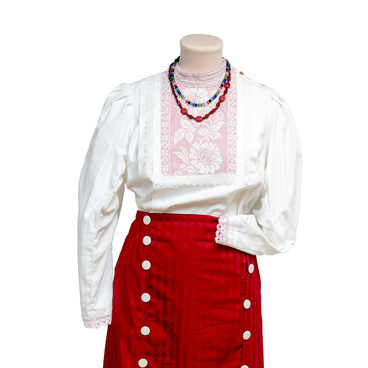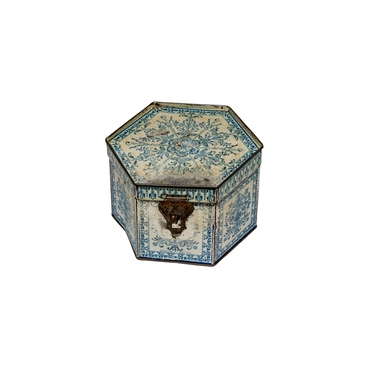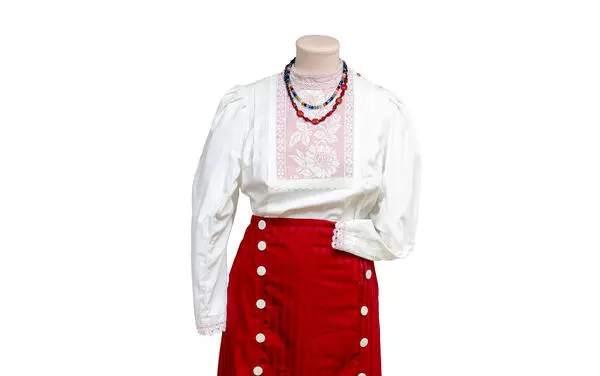The skirt from the collection of Nizhnevartovsk Museum of Local History is a restored item of the traditional costume worn by women in the Middle Ob Region in the 18th century. Tatiana Ilyina sewed it in 2018. The outer side of the skirt is made of thick red fabric, which is a mixture of wool and cotton. The lining is made of dark red fabric. Inside the skirt, there is a pleated frill sewn to the edge of the lining. The front part of the skirt is decorated with two rows of white plastic buttons. There are three small hidden snaps on the left part used to fasten it.
The skirt was a part of “parochka” (consonant with Russian “couple”) that is a women costume consisted of a wide skirt and a slim-waisted blouse with a basque that is a wide frill around the edge. This kind of clothes replaced the traditional sarafans (peasant women’s dresses) by the end of the 19th century. Only elderly women wore earlier sarafans. At first, “parochka” costume became popular among city women. By the end of the 19th century, village women throughout Russia adopted them. However, they used to wear such clothes only on holidays for a long time. The village women wore it rarely and tried to preserve and hand it down to other generations.
Both skirts and blouses for “parochka” costumes were traditionally made of a fabric of the same color and quality. Chintz, cambric, and satin were chosen for summer models, and wool was chosen as winter clothes. Women from rich families wore festive costumes made of silk, velvet, or cashmere.
City women sewed “parochka” basing on fashionable dress patterns and often ordered costumes from professional dressmakers. They also used to order costumes from St. Petersburg. Peasant women, who lived in the villages, sewed costumes determining the size by eye. The necessary amount of fabric was simply remembered from their own experience.
Over time, “parochka” sets turned to become everyday clothes, but not festive. They became a late version of the traditional Russian costume of different provinces. Nowadays, just a few complete costumes are left. Skirts used to be worn out much faster than blouses. That is why they used to be patched, altered, or replaced. The new owners, who inherited such clothes, also fitted costumes to a concrete shape. The women also complemented clothes with more fashionable modern trimmings and changed the style.
The skirt was a part of “parochka” (consonant with Russian “couple”) that is a women costume consisted of a wide skirt and a slim-waisted blouse with a basque that is a wide frill around the edge. This kind of clothes replaced the traditional sarafans (peasant women’s dresses) by the end of the 19th century. Only elderly women wore earlier sarafans. At first, “parochka” costume became popular among city women. By the end of the 19th century, village women throughout Russia adopted them. However, they used to wear such clothes only on holidays for a long time. The village women wore it rarely and tried to preserve and hand it down to other generations.
Both skirts and blouses for “parochka” costumes were traditionally made of a fabric of the same color and quality. Chintz, cambric, and satin were chosen for summer models, and wool was chosen as winter clothes. Women from rich families wore festive costumes made of silk, velvet, or cashmere.
City women sewed “parochka” basing on fashionable dress patterns and often ordered costumes from professional dressmakers. They also used to order costumes from St. Petersburg. Peasant women, who lived in the villages, sewed costumes determining the size by eye. The necessary amount of fabric was simply remembered from their own experience.
Over time, “parochka” sets turned to become everyday clothes, but not festive. They became a late version of the traditional Russian costume of different provinces. Nowadays, just a few complete costumes are left. Skirts used to be worn out much faster than blouses. That is why they used to be patched, altered, or replaced. The new owners, who inherited such clothes, also fitted costumes to a concrete shape. The women also complemented clothes with more fashionable modern trimmings and changed the style.




